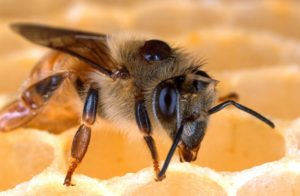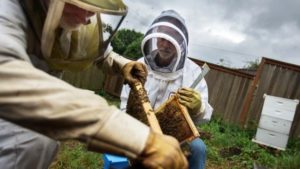Report Back – Francis Ratnieks
A Switch to Natural Resistance
Francis Ratnieks
Before attending Bee Audacious I was asked to provide an audacious suggestion. This was to Breed for Disease Resistance & Focus on Commercial Beekeepers. The interactions I had at BA, both in and out of the sessions, have reinforced this for me as one of the interesting ideas to emerge.
One important reinforcement was the comments of several commercial beekeepers who were clearly worried that current synthetic chemical pest/disease treatments were not working well (e.g., Amitraz against varroa) and would work less well in the future. I also understood better the challenges commercial beekeepers are under, running small businesses that also employ other people whose families depend upon their jobs. Reinforcement also came from the comments of small scale beekeepers who wanted to carry out beekeeping without synthetic chemicals and from the interest in the Tuesday breakout session on Diseases and pests: what are the next generation of controls. I was not the Thought Leader in this session, but I heard that it was popular and that many participants were interested in non-chemical controls. It will be interesting to see if this is reflected in their individual Index Card comments.

Varroa mite on honeybee
Outside the sessions I also spoke to people discussing Darwinian beekeeping and others who were keeping hives in isolated regions without the use of chemical controls. Their comments and perspectives indicate that natural selection can result in honey bee colonies that have good survival without disease treatment and which also show high levels of natural resistance, such as via high levels of hygienic behaviour. Combined with the results of my own research on breeding hygienic bees and their ability to lower varroa population growth and control deformed wing virus, I now feel that the time is right to make an audacious push to increase the use of natural resistance in the control honey bee pests and diseases, possibly aided with some “soft” chemicals such as oxalic acid to help in the control of varroa (as resistance of the varroa to this chemical is unlikely) and with the elimination of synthetic chemicals.
Beekeepers have little to lose by using natural resistance. They are already losing a large proportion of colonies each year even while using synthetic chemicals as these are not always very effective at controlling diseases and pests (e.g., varroa) and can be harmful to the bees (e.g., Amitraz). In addition, several important diseases (e.g., chalk brood, deformed wing virus, have no chemical controls but can be controlled by hygienic behaviour. Furthermore, where does pest and disease control with synthetic chemicals lead? Ultimately, to resistance in the pest or pathogen. It does not lead to pest and disease resistance in the bees.
Action
How can this be extended into action? One audacious way forward is to say that the time is now right for commercial beekeepers to switch to natural resistance. To do this will need assistance from scientists and support teams. Scientists also need to do further research and test and breed bees that have multiple natural resistance adaptations. I do not see how the beekeepers can have success without working with scientists. The scientists will also need help in funding and carrying out their work, and could well also use beekeepers to help in the testing of naturally-resistant bees versus unselected bees (“on farm research”). Beekeepers may also need help from “bee teams” to help monitor disease levels and natural resistance in their hives.
The Process

Francis Ratnieks. Professor of Apiculture, University of Sussex
The dialogue process was a good one for sharing information and combing this in novel ways. However, it cannot be expected to deliver insights that are not in the experience of the participants. Thus, if you want scientific insights you need scientists, and if you want commercial beekeeping experience you need commercial beekeepers. In the public meeting I could see how the insights can easily result in fairly stereotyped audience responses of the “we are destroying the planet, isn’t that terrible” type. It is easy for the broader issues of pesticides or land use and habitat to overwhelm elements of the problem that are more bee-centric.
Other topics
I agree that “habitat” or “habitat and food supply” is a broad unifying message relevant to honey bees and wild bees, and all wild life. Another important message was the need for getting information to beekeepers via extension, bee clubs, books, articles, web sites, videos. etc.





